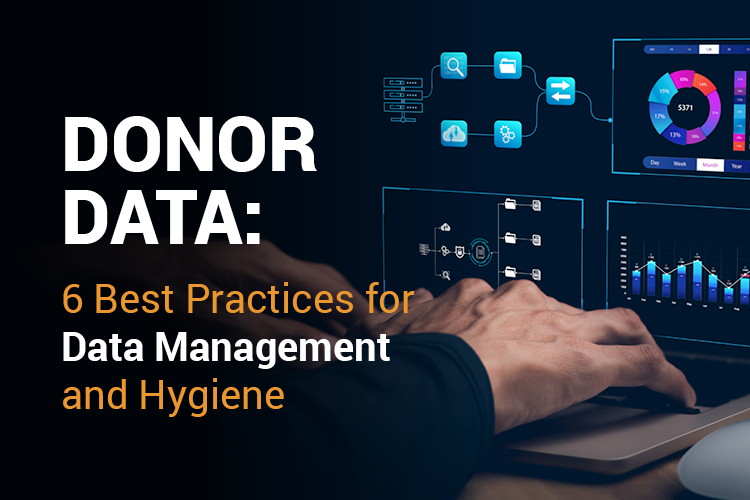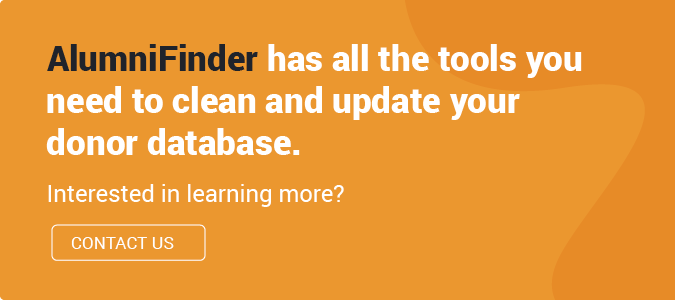
Donor data is essential to your organization’s success. By collecting information about a donor’s preferences and unique motivations for supporting your cause, you can improve your outreach and solicit their ongoing support.
However, to maximize the impact of your donor analytics, you need strategies in place to keep your donor data secure, organized, and up-to-date. In this guide, we’ll explore everything you need to know about managing donor data and keeping it clean, including:
- FAQs About Donor Data
- 6 Best Practices for Donor Data Management and Hygiene
- Wrapping Up: How to Make the Most of Donor Data
Ready to unlock the power of donor data? Let’s start by addressing some common questions.
FAQs About Donor Data
What is donor data management?
Donor data management refers to the strategies that nonprofits, higher education offices, and other mission-driven organizations use to track information about supporters and maintain relationships with them. These strategies include collecting, processing, validating, and storing data.
The main purpose of donor data management is to gain insights that help your organization boost engagement, cultivate relationships, and raise more money.
What is donor data hygiene?
Donor data hygiene is a subset of data management that focuses on ensuring the data your organization holds is accurate, complete, and up-to-date. It involves regularly reviewing your database, supplementing existing data, and removing any outdated or irrelevant metrics from your system.
With clean data, you can better understand your donors, perform accurate donor data analysis, create more effective outreach strategies, and boost their commitment to your cause.
What are the benefits of donor data?
When managed and maintained properly, donor data ensures your nonprofit has accurate and easily accessible information that you can use to solicit support.
Additionally, clean and well-managed data can benefit your organization by:
- Improving donor outreach. Proper data management and hygiene help optimize your marketing and other communication efforts by allowing you to define donor segments, track donor behavior, and develop more personalized communication strategies.
- Boosting donor retention. With donor data management, you can better understand your donors’ motivations and preferences, analyze their giving behavior over time, and develop customized strategies for increased retention. You can also scan through your updated donor analytics to identify donors who have lapsed—or are on the verge of lapsing—and work to regain their support.
- Increasing internal efficiency. Automating management and hygiene processes within your donor database can save time and money, allowing you to focus your resources on other important initiatives.
- Maintaining transparency. Many grantors and other funders require data reports as evidence to prove that your organization will use grant funds wisely. Proper data hygiene practices ensure that you can produce precise reports and maintain transparency.
Let’s explore an example of donor management in action to further highlight the benefits. A higher education office wants to find lost alumni and convert them into donors. Data management can help by providing a centralized repository of alumni data, which can be used to search for alumni and track changes in their contact information. They can then use data hygiene processes to update their mailing addresses, emails, or phone numbers and send personalized communications to reconnect.
6 Best Practices for Donor Data Management and Hygiene
1. Leverage an integrated CRM system.
Spreadsheets were once a common platform for data management. However, they require manual data entry. Therefore, they are more prone to human error.
For a modern, more advanced approach to donor data management, invest in an integrated constituent relationship management (CRM) system, also known as donor management software or a donor database.
CRMs store large amounts of donor data and allow you to find important information in seconds with a simple search query. Look for a system that offers workflow automation, customization, third-party integration, donor tracking, and reporting tools.
Then, follow these steps to make the most of your CRM:
- Keep your data in one place. Make sure your other software solutions integrate with your CRM, so data can flow seamlessly into one centralized location. This will save time otherwise spent switching between platforms to find information.
- Regularly review your database. Depending on your organization’s needs, you should audit your database on a weekly, monthly, or annual basis to assess the integrity of the data and ensure there aren’t any oversights that you need to address.
- Prioritize security. Implement a comprehensive database security policy that covers authentication, authorization, encryption, and other security controls to protect your donors’ sensitive financial and personal information. You should also restrict access to the database to only those who need it and use strong passwords to keep the system secure.
Once you have a powerful CRM in place, you can begin managing your database and determining which metrics are needed to achieve your larger goals.
2. Determine which donor data needs to be collected.
Your team can quickly become overwhelmed by the endless amount of metrics that exist about your donors. To avoid that, focus on tracking information that aligns with your organization’s needs.
As a general rule of thumb, the data you track should be linked to a donor’s ability and desire to give to your organization. It should also help you appeal to their unique preferences and interests to solicit a donation.
To get started, add the following data points to your donor database:
- Demographic information: Age, education level, geographic location, and other personal information can indicate a donor’s engagement habits and help you refine your solicitation strategy. For instance, if you’re hosting an in-person event, you could use your database to quickly identify and invite donors in your local area for the highest event turnout.
- Contact information: Ensure phone numbers, email addresses, mailing addresses, and social media profiles are updated and stored in your database so you can easily contact donors.
- Wealth indicators: Conduct a wealth screening to gain financial insights, such as a donor’s employer, income, real estate ownership, stock ownership, and political giving habits. This will help you determine a donor’s capacity to become a major donor and identify if they’re eligible for matching gifts.
- Donation history: Collect giving information, including the size and frequency of donations, to identify donors who are most likely to maintain or increase their current level of giving and adapt your fundraising strategy accordingly.
- Communication preferences: Measure email open rates, website visits, social media engagement, and direct mail response rates to determine which channels your donors frequent. Focus your outreach efforts on high-performing channels and optimize your strategy on others.
- Past involvement: Involvement information—such as event attendance, leadership roles, and volunteer experience—will help you personalize your outreach and tailor future engagement opportunities to their interests.
- Donor achievements: Track milestones and achievements, like the anniversary of a major gift or an acceptance onto your nonprofit’s board, so your organization can recognize donor accomplishments and improve retention.
Storing this information in your database enables you to perform proper donor data analysis so you can understand donor behaviors and make better-informed decisions about how to cultivate relationships with them.
Be willing to expand your data collection efforts based on your objectives at a given time. For instance, if you’re conducting prospect research, you might collect information about a potential donor’s involvement with another organization to gauge their interest in your mission.
3. Segment donor data for improved outreach.
As you begin collecting data, one of the most effective data management strategies you’ll have at your disposal is segmentation. Donor segmentation is the act of grouping supporters based on shared donor data—such as demographics, giving history, or geographic location—and tailoring your communications to their unique motivations.
Let’s say your organization is prioritizing donor retention. You may choose to target donors according to the length of their relationship with your cause using segments like:
- New donors: New donors require specialized communications to inspire their continued commitment. Thank donors for their contribution and welcome them to your cause. Then, include information about upcoming events and fundraising campaigns to solidify their involvement.
- Major donors: Major gifts can represent a significant portion of your fundraising revenue. Demonstrate the impact of their support and invite them to maintain or increase their level of giving.
- Lapsed donors: Nonprofits naturally lose donors over time, but you shouldn’t give up on soliciting their support. Encourage them to give again by expressing your appreciation for their past involvement and explaining why you need them to rejoin your cause.
With personalized data-driven outreach, you can more effectively engage supporters in your mission.
4. Standardize donor data entry.
Although your CRM will automate much of the donor management process, there will be instances when you need to manually enter data. Follow these tips to ensure your donor data entry is accurate:
- Regulate donor data entry. Create a set of common data fields—such as name, contact information, and donation history—that can be stored in a standardized format. For instance, when entering a donor’s contact information, you may choose between St. or Street for physical addresses and (123) 456 -7890 or 123-457-7890 for phone numbers. Remaining consistent makes it easier to find and organize information later on.
- Establish guidelines for data entry. Create a written internal policy for donor data entry, including who will be tasked with data entry and the rules they should abide by.
- Train your staff. Ensure that those tasked with donor management are well-versed in your data entry and privacy policies so that everyone is on the same page.
As you implement these data hygiene practices, prepare for exceptions. For example, if you decide to spell out job titles but notice over time that it’s time-consuming, abbreviate the titles moving forward and refine your written policy accordingly.
5. Devote time to donor data analysis.
If you’re having trouble making sense of your metrics, turn to data visualization. Task a team member with turning complex data related to donor behavior into digestible charts, diagrams, and graphs. That way, you can quickly identify trends in donor data and make more informed decisions about their engagement through donor data analytics.
You can also compile these visualizations into financial reports to explain difficult concepts to board members and other key stakeholders.
6. Invest in professional donor data enhancement.
Whether you’re missing contact information or wealth markers, data appends can fill in the gaps in your donor database. Appending data involves using a third-party source to supplement your existing donor data and add new information to your records.
When you partner with a data provider like AlumniFinder, you can append data such as:
- Phone numbers
- Email addresses
- Mailing addresses
- Social media profiles
- Net worth
- Giving history
By updating or adding this information to your CRM, you can ensure that your database is not only accurate but also robust.
Wrapping Up: How to Make the Most of Donor Data
Now that you know how best to maintain donor data, you can begin the process. For the best results, partner with experienced data management and hygiene experts like AlumniFinder. With more data available than any other company, AlumniFinder is uniquely positioned to ensure that your organization has the information it needs to succeed.
If you want to learn more about data and how it can support your larger efforts, consider exploring these additional resources:
- Tools for the 21st Century: A Modern Fundraiser’s Success Kit. Learn how to use donor data to improve your fundraising efforts with the tools and strategies suggested in this guide.
- The Fundraiser’s Guide to a Good Data Hygiene Routine. Explore how data hygiene strategies can support your fundraising goals.
- Data Quality Report. Check the accuracy of your data and identify gaps in your records with AlumniFinder’s free Data Quality Report.


